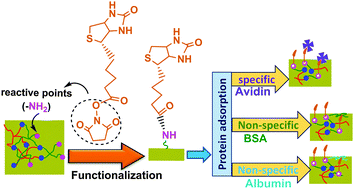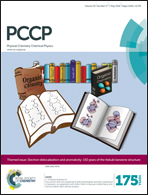Chemical derivatization and biofunctionalization of hydrogel nanomembranes for potential biomedical and biosensor applications†
Abstract
Poly(ethylene glycol) based hydrogel nanomembranes (PHMs) are demonstrated to be able to host protein-specific receptors, providing, at the same time, stable, protein-repelling matrices with a characteristic mesh size up to 7–8 nm. The membranes were prepared by crosslinking of amino- and epoxy-terminated STAR-PEG precursors and maintained their hydrogel and protein-repelling properties even at a deviation of the precursor composition from the equilibrium value (1 : 1). The grafting density of the test avidin protein, specifically attached to the biotin moieties coupled to the free amine groups in the PHMs, varied from 0.45 × 1012 to 1.3 × 1012 proteins per cm2 within the sampling depth of the experiments (∼11.5 nm), depending on the precursor composition, whereas the analogous values for the non-specifically adsorbed proteins were lower by a factor of 4–5. The engineering of PHMs with biomolecule-specific receptors and their loading with biomolecules are of potential interest for sensor fabrication and biomedical applications, including tissue engineering and regenerative therapy.


 Please wait while we load your content...
Please wait while we load your content...